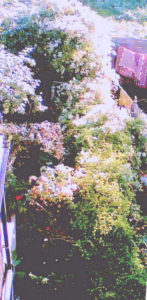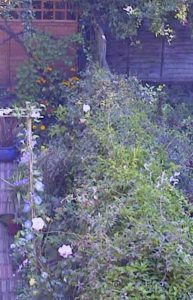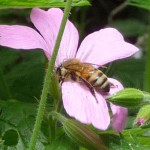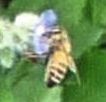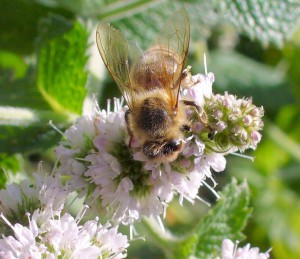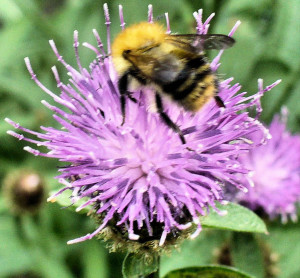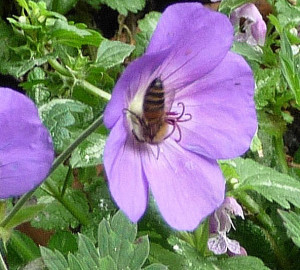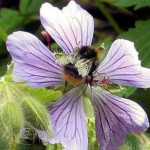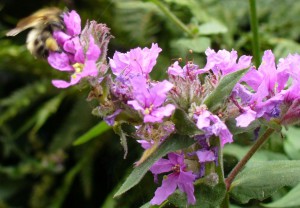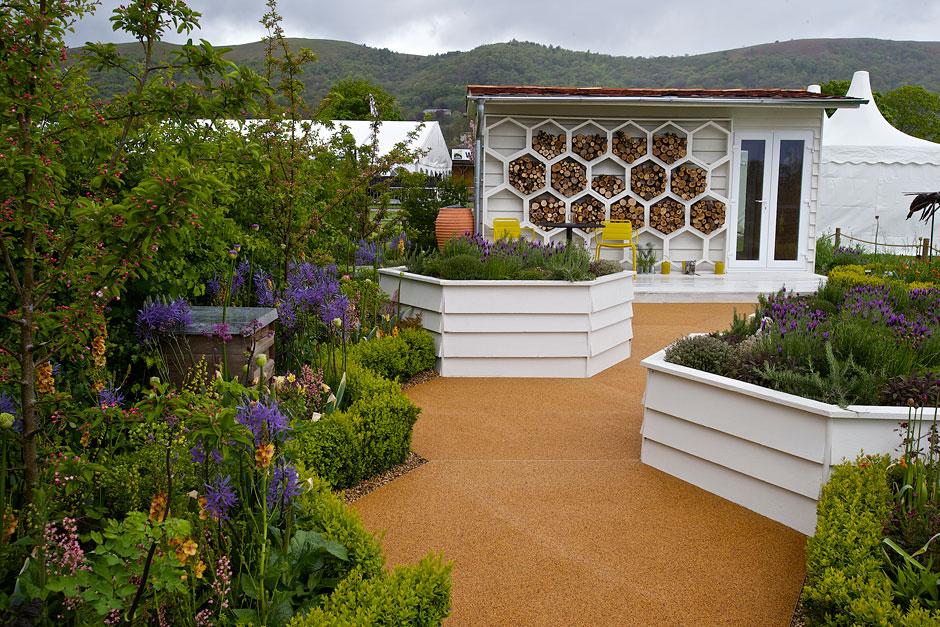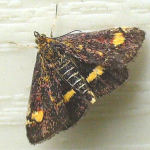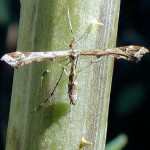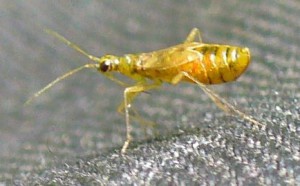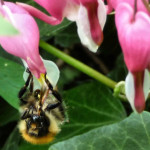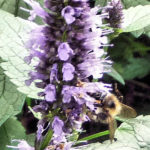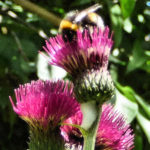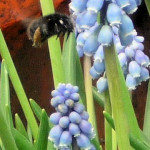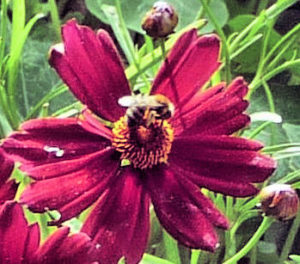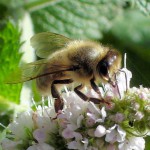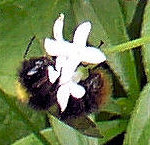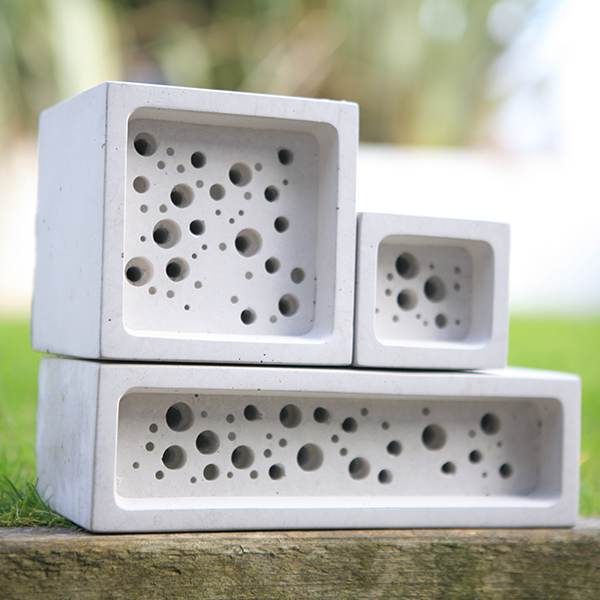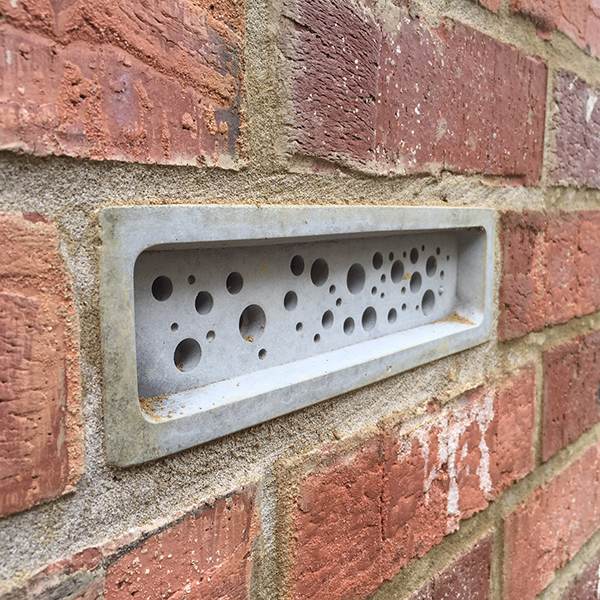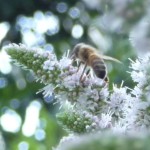Walls, fences and hedges – the boundaries between our properties – are not barriers to pollinators.
A bee going from flower to flower will take no notice of a wall or fence between gardens.
But when the second garden is concrete, or its flowers have no pollen or nectar, pollinators have no reason to visit.
Our most important pollinators, the honeybees, are in trouble. Beekeepers are dealing with ‘colony collapse disorder’ & a parasite, the varroa mite. Chemical pesticides used in gardens & countryside leave the bees disoriented, unable to remember where they are & forgetting the way back to their hives. Bumblebees too are in trouble, with numbers declining.
If plants in our gardens or windowboxes attracted honeybees, bumblebees & other pollinators, drawing them along a virtual river of wildflowers (see Bees Favourites pages for some suggestions) we could be working together to get Britain buzzing again. Wherever you are, if there are birds, bees, or butterflies flourishing nearby, you should be able to plant something that will bring them into your windowbox, onto your patch.
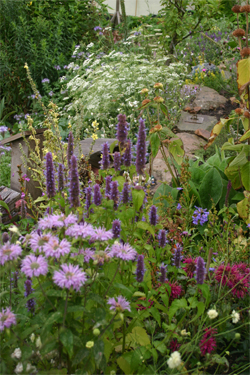
Marc Carlton’s 2010 cottage garden pollinator border, designed to attract wild bees & hoverflies.
http://www.foxleas.com – THE POLLINATOR GARDEN
Gardener and ecologist Marc Carlton created this clear & extensive website, based on his experience of bringing more wildlife into his south London garden. He wants it to be printed &/or downloaded for personal or non-commercial use. Now living in Chepstow, Marc Carlton welcomes emails & will usually be available to give talks in the area (Bristol and North Wales). In THE POLLINATOR GARDEN, you will find:
* How insects feed from flowers
* A planting list for pollinators
* The basics of nature-friendly gardening
* Garden meadows
* Recommended reading lists
* Links to helpful sites
* Nature gardens in Holland and Germany, and a North American page for readers in the USA/Canada
Planting lists from THE POLLINATOR GARDEN will, we hope, be used by those in charge of parks and gardens as well as gardeners. We can all choose wildlife-friendly plants that offer the most pollen and nectar to our bees.

The BBCT is a small charity working to raise public awareness about the plight of UK bumblebees. The Trust, with members & volunteers, examines the dangers facing our bumblebees & creates strategies to help them.
BBCT supports a “future in which our communities and countryside are rich in bumblebees and colourful flowers, supporting a diversity of wildlife and habitats for everyone to enjoy”.
Author & scientist Prof. Dave Goulson founded the Trust after finding a link between bumblebee deaths & Nicotine-based pesticides (Neonicotinoids or Neonics). Bumblebees visiting flowers treated with these toxic substances become confused, losing the ability to find their way back to their nests.
The Government currently supports a ban on these pesticides for a number of crops, following recommendations from the UK ECP (Expert Committee on Pesticides.)
Dave Goulson was interviewed by Jim al-Khalili for BBC Radio 4’s series The Life Scientific on 11 Nov 2014. He chatted about life, science, bumblebees & the case against Neonics. You can download this programme, which is 13MB and lasts for 28 minutes : www.bbc.co.uk/podcasts/series
Support for The BBCT
* SCHOOLS ARE HELPING BEES : POLLI:NATION
In this innovative biodiversity project, 260 UK schools, community groups & individuals are helping pollinators. Secondary & Primary school pupils survey their garden or school grounds to learn what pollinators need, making sure there is plenty of food & shelter.
Young people have been making school grounds into pollinator havens – creating vertical green walls & night-blooming flower beds, debating pesticide use & lobbying to change school maintenance regimes. BBCT is involved. Read more about the Polli:Nation scheme :
http://www.polli-nation.co.uk/about/
* EASYFUNDRAISING
 Over 3,700 UK retailers have registered with this site to raise funds for BBCT. When you shop online, (for groceries, train tickets, hotel rooms & more) retailers from Apple to Waitrose donate a percentage of what you spend to the charity.
Over 3,700 UK retailers have registered with this site to raise funds for BBCT. When you shop online, (for groceries, train tickets, hotel rooms & more) retailers from Apple to Waitrose donate a percentage of what you spend to the charity.
Go to http://www.easyfundraising.org.uk/invite/2P51H7/ & click to sign up. Look through the easyfundraising website, choose a retailer & click on your purchase. The retailer will give you a cash reward that easyfundraising turns into a donation for BBCT, as well as an extra £1 from your first donation at no extra cost to you.
* THE ‘BEES KNEES’ – Show Garden by Martyn Wilson
The plight of UK bees was highlighted in the 2015 RHS Malvern Spring Festival Garden by designer & RHS Silver Medal winner Martyn Wilson. He created a show garden, THE ‘BEE’S KNEES’ to support BBCT. The garden’s design, with bee-friendly plants in hexagonal beds, was inspired by the honeycomb. It won Silver Gilt at the show & featured on Gardener’s World.
“I am very proud to be building a garden in association with the Bumblebee Conservation Trust. These cheery bundles of fluff have always fascinated me. Their gentle hum keeps me company during the summer months & as an ex-RAF officer I can’t help but marvel at their aerodynamics. I was so concerned on hearing about the dramatic decline in their numbers &, realising their essential contribution to our ecosystem, I felt compelled to do something to support them. If just one person walks away from my garden deciding to help that will make me happy.”
Martyn Wilson in BBCT’s April 2015 newsletter
https://www.rhs.org.uk/shows-events/malvern-spring-festival/exhibitors/2015/gardens/the-bees-knees
Join BUMBLEBEE CONSERVATION UK
You can help make sure that these charismatic creatures are around for future generations to enjoy by becoming a member.
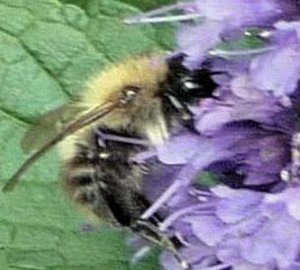
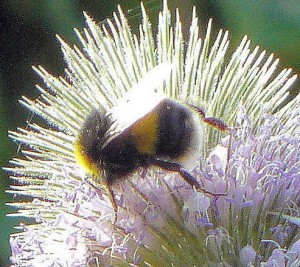 Members help the Trust create & restore wildflower habitats, raise awareness about bumblebees & support BeeWalk, the national citizen science project that surveys bumblebee populations & encourages bee-friendly gardening across the country.
Members help the Trust create & restore wildflower habitats, raise awareness about bumblebees & support BeeWalk, the national citizen science project that surveys bumblebee populations & encourages bee-friendly gardening across the country.
In BBCT‘s newsletter ‘Buzzword’, sent to all members by post or online 3 times a year, you will find bumblebee news, articles & project updates. To see how bee-friendly your garden is, use the Bee Kind tool on the website. There is a photo gallery of British bees & you can sign up for the free newsletter:
Bumblebee Conservation Trust, Beta Centre, Stirling University Innovation Park, FK9 4NF
BEALTAINE COTTAGE
These are the youtube blogs of writer & environmentalist Colette O’Neill, who has planted up 3 acres of land in the West of Ireland with Mother Earth in mind. Bees – mostly solitary bees & bumblebees – benefit greatly from the permaculture method, in which everything is planted quite close to its neighbours, & no bare earth is left.
Colette emphasizes that a queen bee, on waking from hibernation in spring, has only 40 minutes to find enough nectar to keep her alive. Otherwise she will die, & with her the next generation of her family of bees. It is vital that we, in our gardens, patios & windowboxes, have nectar-bearing flowers waiting for the early bees in spring.
In Colette‘s videos she walks round her densely planted mini woodland with Jack, her ever-enthusiastic Border Collie. She holds up a camera as she goes, & chats about many things – the planting, the weather, the Celtic calendar, her thoughts on many things. You are, in effect, walking with them as a friend.
The Bealtaine Cottage blog currently has 36,939 subscribers. Some are gardeners, some are soothed and charmed by the sound of Colette’s voice, some enjoy the walk with Colette & Jack. Also drawing in the viewers are visits to ancient sites, drives in the countryside, walks in woodlands.
You can support Colette by purchasing books she has written about The Bealtaine Project, as well as calendars, bumper stickers & a double sided map (right) by Irish artist David Gascoigne.
https://bealtainecottage.com/bealtaine-cottage-publications-
Sarah Raven : PLANT A RIVER OF WILDFLOWERS
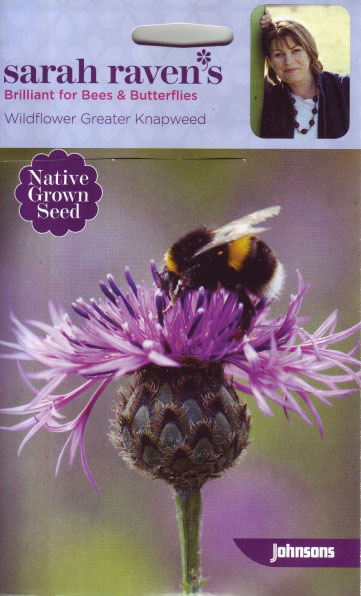 Before London 2012’s Olympic games, gardener & writer Sarah Raven urged the public to help stop the decline in pollinators & get Britain buzzing again by planting a River of Wildflowers.
Before London 2012’s Olympic games, gardener & writer Sarah Raven urged the public to help stop the decline in pollinators & get Britain buzzing again by planting a River of Wildflowers.
Sarah, known for her work at Sissinghurst & appearances on BBC’s Gardener’s World, appears in clips from her series Bees Butterflies and Blooms on BBC2’s website, as meadows are sown for the new Olympic park. Three meadow wildflower mixes were trialled & the best chosen for longest flowering & pollinator attraction.
Sarah’s campaign to increase pollinator numbers began at her cutting garden at Perch Hill Farm. She persuaded a neighbouring farmer to leave a strip of his land for wildflowers. Pollinators visiting Sarah’s farm can now cross over to the new wildflower strip as if flying up a river, a river of wildflowers.
Visit Sarah’s website for inspiration. You can order books, plants & seeds, sign up for a course or arrange to receive her newsletter.
Sarah Raven’s Garden and Cookery School, Perch Hill Farm, Willingford Lane, Brightling, Robertsbridge East Sussex TN32 5HP
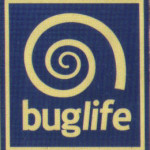
BUGLIFE * The Invertebrate Trust
Saving the small things that run the planet
Buglife is a small charity that campaigns to protect bugs & the environment. It involves people in conservation action, learning about & enjoying bugs.
One in three mouthfuls of our food (including tomatoes, honey, chocolate & coffee) depends on insect pollination. Bugs are vitally important to a healthy planet. Humans & other life forms couldn’t survive without them. The crops that fed our ancestors were pollinated by a rich pallette of buzzing insect. Their future health is now in our hands.
‘If we and the rest of the backboned animals were to disappear overnight, the rest of the world would get on pretty well. But if the invertebrates were to disappear, the world’s ecosystems would collapse.’
Sir David Attenborough
On the Buglife website you can find details about bumblebee likes & dislikes. [They dislike INSECTICIDES (including organic ones), MOST BEDDING PLANTS (Petunias, Busy Lizzies, French Marigolds, Pelargoniums, Pansies, etc.), ‘DOUBLE’ FLOWERS (where stamens are replaced by extra rows of petals) & other highly-hybridized horticultural novelties]. There is an e-newsletter, info for schools & young insect lovers, a UK bug map, events, activities & a bug identifier (What’s that bug?)
GET BRITAIN BUZZING / A Manifesto for Pollinators came out in March 2014 & is on the internet. It gives details of the problems facing pollinators & what needs to be done to tip the balance back in favour of biodiversity. Its suggestions are for local authorities, council planning departments, parks, gardens, & Government. Green roofs, B-lines & rain gardens will not be enough if it is only the country’s gardeners who respond. Read the Manifesto yourself &, if you have any influence over someone with influence – get them to read it & urge them to act on it.
https://www.buglife.org.uk/sites/…/Pollinator%20manifesto%20with%20covers_1.pdf
The Soil Association urges the public to boycott neonicotinoids (neonics), toxic nicotine-based pesticides. Read about these bee-damaging substances, and see their infographic The Secret Poisoning of our Countryside, on :
https://www.soilassociation.org/media/6964/ban-neonics-infographic.pdf
Prof Dave Goulson, founder of The Bumblebee Trust, cites evidence of bees and other wildlife being quietly poisoned by chemicals 5,000 times more toxic than DDT: “Studies on neonicotinoids have overwhelmingly found negative effects on bumblebee colonies and behaviour – and the very same chemicals which are killing bees are still readily available in any garden centre.”
Dave Goulson’s piece ‘The Toxic Bouquet’ is one of the blogs on the website.
https://www.soilassociation.org/
SHOPPING
Look into websites; try to find out how ecological & committed a shop or business is. Two of our major supermarkets give their details on the internet, such as what they are doing for bees:
WAITROSE
Visit the Waitrose website to see their policies on genetically modified food, fair trade, palm oil and more. To support British bees, they avoid the use of neonicotinoids in the production of the food and drink that they sell.
Waitrose Garden is selling a new innovation, the Bee Brick, to provide homes for solitary bees.
‘The bee brick is an innovative new product which has been designed to provide a manmade nesting site to support the declining solitary bee population. Whether positioned as a freestanding bee nest in the garden or allotment, or as an integral part of a building, the bee brick provides additional habitats for bees in spaces where they may otherwise have been forced out.
Each bee brick contains cavities for solitary bees to lay their eggs. Each cavity is moulded part way into the brick ensuring bees cannot enter the building. Bees lay their eggs inside the holes and seal the entrance with mud or chewed up vegetation. The offspring emerge the following spring and begin the cycle again.
The bee bricks and blocks are designed and made by Green and Blue in Cornwall from polished cast concrete. They should be positioned in a warm sunny spot, preferably south facing, with no vegetation in front of the holes, ideally at around 1 metre from the ground.
The bee brick won The Soil Association’s 2014 Innovation Award, sponsored by the Duchy Future Farming Programme. The Programme works with farmers and researchers and focuses on low-cost, sustainable solutions that rely on management practices or renewable resources. It aims to boost innovation in organic and other low-input farming while improving productivity and giving environmental benefits. The Programme is delivered by The Soil Association, in partnership with the Organic Research Centre and supported by Waitrose Duchy Organic.‘
http://www.waitrosegarden.com/product/_/bee-brick/classid.2000027819/
SAINSBURYS
On the Sainsburys site, under Responsibility, Respect for our Environment, they say:
‘We aim to be the UK’s greenest grocer, not only by reducing our impact on the environment but by engaging our suppliers and others to do the same.’
J.Sainsbury.plc
On the internet, Sainsburys have full instructions on how to make your own bee hotel for solitary bees.
‘Sainsbury’s has over one hundred Bee Hotels on its stores across the country, all of which currently have bees in residence for the winter. Bee Hotels work best when fixed rigidly to a fence or wall facing towards the early morning sun with a clear, unobstructed flight path.’
http://www.j-sainsbury.co.uk/media/latest-stories/2013/20130925-sainsburys-helps-tackle-potential-bee-housing-crisis
